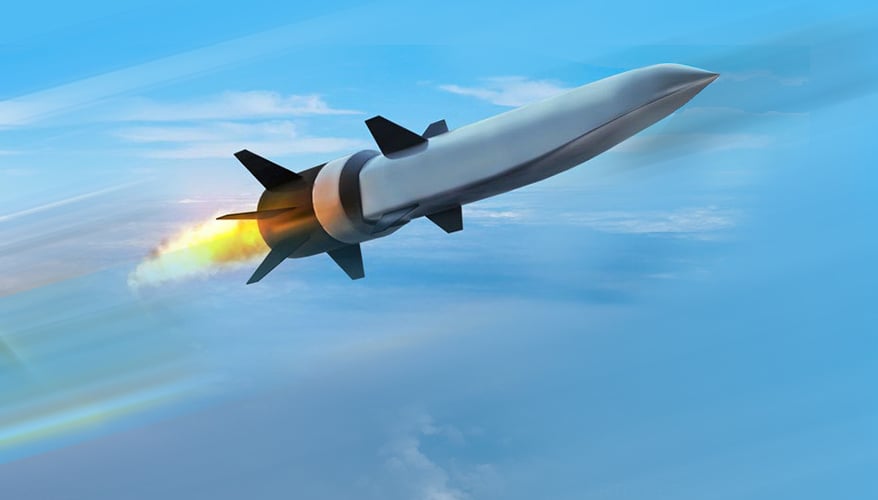
Raytheon concept for an air-breathing hypersonic cruise missile image
WASHINGTON: The Defense Department’s joint effort with Australia to develop an air-breathing hypersonic cruise missile took a step forward yesterday, with the Air Force issuing round-two contract options to Boeing and Lockheed Martin.
The program, called Southern Cross Integrated Flight Research Experiment (SCIFiRE), is aimed at maturing “a solid-rocket boosted, air-breathing, hypersonic conventional cruise missile, air-launched from existing fighter/bomber aircraft, through the completion of a preliminary design review,” according to the DoD contract announcement.
The joint program — signed into existence by DoD and Australia’s Ministry of Defense Last November — is an Allied Prototyping Initiative (API) under the the Office of the Under Secretary of Defense for Research and Engineering. It is being executed by the Air Force. And as with all things hypersonic, the service is not being super forthcoming about what exact technologies are being developed on what exact timetable.
“The new weapon will be a Mach 5-class precision strike missile that is propulsion-launched and powered by an air-breathing scramjet engine,” states the Australian Air Force website. “It will be capable of being carried by tactical fighter aircraft such as the F/A-18F Super Hornet, EA-18G Growler and F-35A Lightning II, as well as the P-8A Poseidon maritime surveillance aircraft.”
SCIFiRE is an outgrowth of a previous US-Australian collaboration, begun in 2007, called the Hypersonic International Flight Research Experimentation (HIFiRE) program, which aimed to develop baseline hypersonic technologies. “The most recent HIFiRE test, successfully conducted in July 2017, explored the flight dynamics of a Mach 8 hypersonic glide vehicle, while previous tests explored scramjet engine technologies,” explains the Congressional Research Service (CRS) in a report updated Aug. 25.
SCIFiRE, CRS explains, is aimed at furthering air-breathing hypersonic technologies, with demo tests “expected by the mid -2020s.” A key advantage for DoD in working with its Australian counterparts is the Woomera Test Range, which is one of the largest weapons test facilities in the world. “Australia reportedly operates seven hypersonic wind tunnels and is capable of testing speeds of up to Mach 30,” CRS notes.
According to a March Government Accountability Office report, SCIFiRE intends “to demonstrate an operational hypersonic cruise missile through two to four flight tests,” with the effort being viewed by the Air Force as a bridge between the joint DARPA-Air Force Hypersonic Air-breathing Weapon Concept (HAWC) project.
The Air Force chose Boeing, Lockheed Martin and Raytheon in June to compete in an initial effort, bringing their designs through Systems Requirements Review. It awarded contracts with potential values of up to $47.2 million to Boeing, $33.5 million to Lockheed Martin and $33.7 million to Raytheon under an options scheme.
Yesterday, the Air Force exercised follow-on contract options for Boeing and Lockheed to continue work through next August to take the program through Phase 1 Preliminary Design Review. The award to Boeing was worth $39.7 million; to Lockheed Martin, $27.2 million.
While Raytheon has not been granted a follow-on option at this time, a spokesperson said today that this does not equate to the company being cut from the program. “We continue to work the program elements we’ve already been awarded,” the spokesperson said. (This statement likely means that the issue is timing — so keep an eye open for another Air Force announcement.)
Hypersonic cruise missiles would be smaller than the boost-glide systems that use a conventional rocket boosters to accelerate the weapon to Mach 5-plus, after which the glide body containing the warhead detaches from the booster and coasts, skipping along the upper limits of the atmosphere like a stone across a pond.
The beauty of air-breathing missiles powered by scramjets — at least for the Air Force — is that they can be made smaller, and thus can be carried by fighter jets and not just larger bomber aircraft. They also are potentially cheaper.
The downside is that hypersonic cruise missile tech, at least up to now, hasn’t been considered as mature as boost-glide capability (some 56% of current DoD investment in hypersonic missiles is in boost-glide systems, according to GAO).
That said, the Air Force has been struggling to get its signature boost-glide effort, the AGM-183 Air Launched Rapid Response Weapon (ARRW), off the ground. ARRW, for which Lockheed Martin is the prime contractor, in July flopped a second flight test because its motor failed to ignite.
In a ‘world first,’ DARPA project demonstrates AI dogfighting in real jet
“The potential for machine learning in aviation, whether military or civil, is enormous,” said Air Force Col. James Valpiani. “And these fundamental questions of how do we do it, how do we do it safely, how do we train them, are the questions that we are trying to get after.”


























